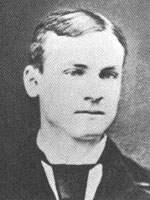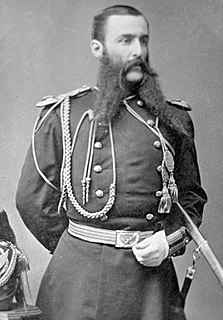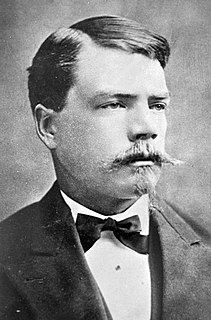| George Edwin Lord | |
|---|---|
| Born | February 17, 1846 Brunswick, Maine |
| Died | June 25, 1876 (aged 30) Montana |
| Allegiance | United States of America |
| Service/ | United States Army |
| Years of service | 1875–76 |
| Rank | Assistant Surgeon |
| Unit | 7th U.S. Cavalry |
| Battles/wars | |
George Edwin Lord (February 17, 1846 - June 25, 1876) was a U.S. Army Assistant Surgeon in the 7th Cavalry who was killed in the Battle of the Little Big Horn in Montana Territory during the Black Hills War.

In modern medicine, a surgeon is a physician who performs surgical operations. There are also surgeons in podiatry, dentistry maxillofacial surgeon and the veterinary fields.

The 7th Cavalry Regiment is a United States Army cavalry regiment formed in 1866. Its official nickname is "Garryowen", after the Irish air "Garryowen" that was adopted as its march tune.

The Territory of Montana was an organized incorporated territory of the United States that existed from May 26, 1864, until November 8, 1889, when it was admitted as the 41st state in the Union as the state of Montana.
Lord was born in Brunswick, Maine and graduated from Bowdoin College. He attended medical school and moved west to serve in the U.S. Army at various forts and outposts. He entered into another contract with the U. S. Army in January 1875 and was made a first lieutenant in the 7th Cavalry, posted in Fort Abraham Lincoln in the Dakota Territory.

Brunswick is a town in Cumberland County, Maine, United States. The population was 20,278 at the 2010 United States Census. Part of the Portland-South Portland-Biddeford metropolitan area, Brunswick is home to Bowdoin College, the Bowdoin College Museum of Art, the Peary-MacMillan Arctic Museum, and the Maine State Music Theatre. It was formerly home to the U.S. Naval Air Station Brunswick, which was permanently closed on May 31, 2011.

Bowdoin College is a private liberal arts college in Brunswick, Maine. At the time Bowdoin was chartered, in 1794, Maine was still a part of the Commonwealth of Massachusetts. The college offers 34 majors and 36 minors, as well as several joint engineering programs with Columbia, Caltech, Dartmouth College, and The University of Maine.
First lieutenant is a commissioned officer military rank in many armed forces and, in some forces, an appointment.
During the Great Sioux War, he accompanied Lt. Col. George Armstrong Custer's column towards the Little Bighorn River, where he was killed in action. Dr. Lord's body was not positively identified by the first burial crews, and he was initially listed by General Alfred H. Terry and others as missing in action. Captain Otto E. Michaelis and Lieutenant Richard E. Thompson, however, later contacted Lord's brother with their belief that a body sighted on the field had been the doctor's, based on a blue shirt the corpse was wearing as well as "the shapely hands, the moustache, and general appearance." [1] :38–39 Michaelis also thought the socks on the corpse were from the same set of three pairs Lord had earlier purchased from a trader at Powder River. Based on this new information, three months after the battle Terry recommended that Lord's status be changed to killed in action. [1] :39–40

George Armstrong Custer was a United States Army officer and cavalry commander in the American Civil War and the American Indian Wars.

The Little Bighorn River is a 138-mile-long (222 km) tributary of the Bighorn River in the United States in the states of Montana and Wyoming. The Battle of the Little Bighorn, also known as the Battle of the Greasy Grass, was fought on its banks on June 25th and 26th, 1876, as well as the Battle of Crow Agency in 1887.
However, there is no marker with Lord's name at the Little Bighorn Battlefield National Monument that specifically marks this reported death site. In 1890, a marker for Lord was placed on the so-called South Skirmish Line, based on the discovery there of buttons that were thought to be part of a staff officer's uniform which doctors would wear. [1] :41

Little Bighorn Battlefield National Monument preserves the site of the June 25 and 26, 1876, Battle of the Little Bighorn, near Crow Agency, Montana, in the United States. It also serves as a memorial to those who fought in the battle: George Armstrong Custer's 7th Cavalry and a combined Lakota-Northern Cheyenne and Arapaho force. Custer National Cemetery, on the battlefield, is part of the national monument. The site of a related military action led by Marcus Reno and Frederick Benteen is also part of the national monument, but is about 3 miles (5 km) southeast of the Little Bighorn battlefield.
Lord's surgical kit eventually was recovered from the Indians and sent to the Army's medical museum.











